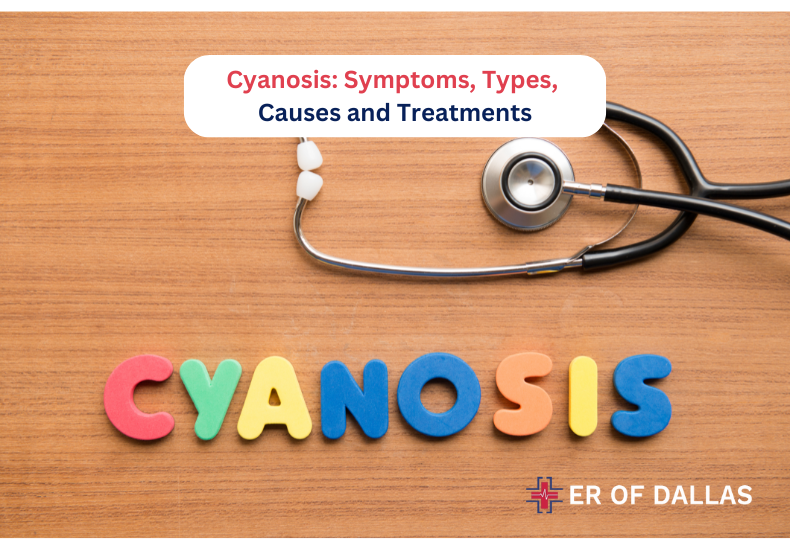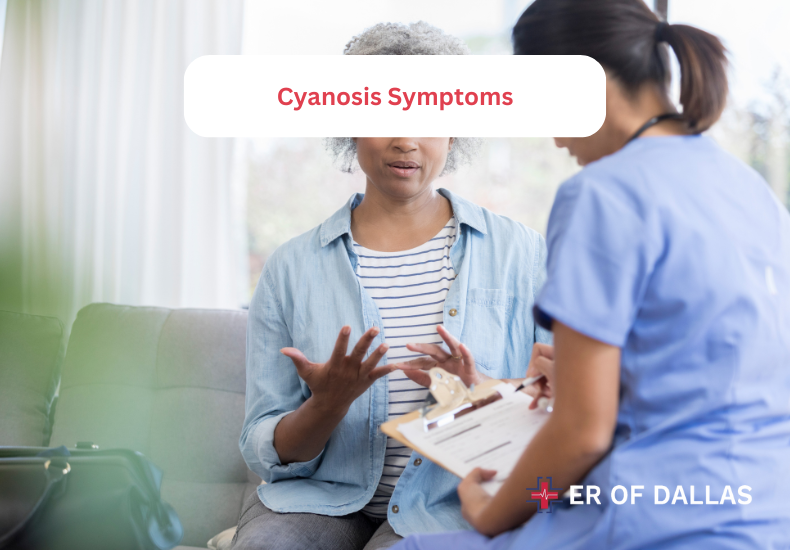Cyanosis: Symptoms, Types, Causes and Treatments
Cyanosis is a condition where your skin or lips turn bluish due to a lack of oxygen in the blood. It can be a sign of serious heart, lung, or circulation issues.
But what causes this concerning change in skin color? How can you recognize its early symptoms? And most importantly, what treatments can provide quick relief?
What Is Cyanosis?
Cyanosis occurs when oxygen levels in the blood drop, causing the skin, lips, and nails to appear blue or purplish. This can be due to reduced oxygenated hemoglobin in the blood, leading to poor oxygen delivery to tissues. While cyanosis itself isn’t a disease, it’s a critical indicator of an underlying issue, often related to respiratory or cardiovascular conditions.
Types of Cyanosis
Cyanosis can be categorized into two main types:
- Central Cyanosis
Central cyanosis affects the central parts of the body, such as the tongue, lips, and torso. It results from systemic low oxygen saturation and is usually associated with serious heart or lung problems, like congenital heart defects or severe respiratory failure. In infants, central cyanosis is a significant concern, especially within the first hours of birth. - Peripheral Cyanosis
This type is more localized and affects the extremities, such as fingers, toes, and nails. Peripheral cyanosis often results from poor blood circulation or cold exposure, where blood flow is constricted, but it may not necessarily indicate severe oxygen deficiency. It’s more common in adults and can be linked to issues like Raynaud’s disease or arterial blockages.
Cyanosis Symptoms
The primary symptom of cyanosis is the bluish coloration of the skin, but other associated signs can include:
- Bluish lips, nails, and tongue (in central cyanosis)
- Pale or cold extremities (in peripheral cyanosis)
- Shortness of breath or difficulty breathing
- Rapid heartbeat or palpitations
- Fatigue or lethargy
- Chest pain in more severe cases
In infants, cyanosis is a major red flag for congenital heart diseases or lung problems. If parents notice persistent bluish skin, particularly around the lips and face, it’s crucial to seek medical care immediately.
Cyanosis Causes
Heart-Related Causes
Conditions that affect the heart’s ability to pump oxygen-rich blood throughout the body can lead to cyanosis:
- Congenital heart defects: Heart abnormalities present from birth, such as Tetralogy of Fallot or transposition of the great arteries, can cause cyanosis, especially in infants.
- Heart failure: The heart’s weakened state reduces its ability to circulate oxygenated blood effectively.
- Pulmonary embolism: A blood clot in the lungs can hinder oxygen exchange, leading to cyanosis.
Lung-Related Causes
Lung conditions that impair the exchange of oxygen can also be responsible for cyanosis:
- Chronic obstructive pulmonary disease (COPD): Severe lung diseases like emphysema or chronic bronchitis can lower oxygen levels.
- Pneumonia: Infections of the lungs can restrict breathing and oxygen uptake.
- Asthma attacks: Severe asthma can cause airway constriction, leading to cyanosis.
- Pulmonary hypertension: High blood pressure in the lungs restricts oxygen flow, potentially causing cyanosis.
Blood-Related Causes
Blood disorders that impair oxygen transport include:
- Anemia: Severe cases of anemia can lead to oxygen-deficient blood.
- Methemoglobinemia: A condition in which hemoglobin is altered, reducing its ability to carry oxygen.
- Carbon monoxide poisoning: This type of poisoning can prevent oxygen from binding to hemoglobin, causing cyanosis.
Cyanosis Treatments
Treatment for Cyanotic skin depends on the underlying cause. Addressing the root medical issue is key to improving oxygen levels in the blood.
Oxygen Therapy
Administering supplemental oxygen is often the first-line treatment for cyanosis, particularly in emergencies. Oxygen therapy can be delivered through nasal prongs, face masks, or ventilators, depending on the severity of the condition.
Medications
- Bronchodilators: These are commonly used for asthma or COPD-related cyanosis to open up airways.
- Diuretics: For heart failure, diuretics can help reduce fluid buildup and improve circulation.
- Antibiotics: Pneumonia-induced cyanosis may require antibiotics to treat the infection.
- Blood thinners: For pulmonary embolism, anticoagulants (blood thinners) can prevent further clots from forming.
Surgical Intervention
For congenital heart defects causing cyanosis in infants, surgical repair may be necessary. Corrective procedures like balloon angioplasty may help restore proper blood flow and oxygenation.
Lifestyle Changes
Managing underlying chronic conditions like heart disease or COPD may include adopting healthier habits such as smoking cessation, maintaining a healthy diet, and staying active to improve cardiovascular function.
Cyanosis Prevention
While some causes of cyanosis are unavoidable, like congenital heart conditions, there are measures that can help prevent Bluish skin or reduce its severity:
- Avoid smoking: Smoking severely affects lung and heart health, contributing to conditions that may cause cyanosis.
- Manage chronic illnesses: Keeping conditions like heart failure, COPD, or asthma under control with proper medication and lifestyle changes reduces the risk of cyanosis.
- Stay warm: In cases of peripheral cyanosis, keeping extremities warm can improve circulation.
- Monitor oxygen levels: If you’re at risk for cyanosis due to lung or heart conditions, using an oximeter to check blood oxygen levels can help prevent a crisis.
When to See a Doctor
Cyanosis, particularly central cyanosis, is a medical emergency. Seek immediate medical attention if you notice:
- Sudden onset of cyanosis
- Difficulty breathing or chest pain
- Rapid heartbeat
- Cyanosis in infants, especially in the first hours after birth
- Cyanosis that doesn’t improve with warming or oxygen
In an emergency, the ER of Dallas, or any nearby healthcare facility, can provide critical care, including oxygen therapy and necessary interventions to stabilize the patient.
Cyanosis Tests
To diagnose the underlying cause of cyanosis, several tests may be performed:
- Pulse oximetry: A non-invasive test that measures the oxygen saturation in the blood.
- Arterial blood gas test (ABG): This test measures the levels of oxygen and carbon dioxide in the blood, providing more detailed information about respiratory function.
- Chest X-Ray: To detect lung conditions like pneumonia or pulmonary embolism.
- Echocardiogram: An ultrasound of the heart to check for congenital defects or heart failure.
- Blood tests: To rule out anemia or methemoglobinemia.
Conclusion
Cyanosis is a visible sign indicating a problem with the body’s oxygen delivery system, often suggesting underlying heart, lung, or blood conditions. Early recognition, prompt diagnosis, and appropriate treatment are crucial to preventing complications. If you or someone you know exhibits signs of cyanosis, particularly central cyanosis, seek medical care immediately to prevent further health deterioration.
ER of Dallas provides rapid and comprehensive care for patients facing urgent medical conditions, including cyanosis. With a team of experienced healthcare professionals and advanced diagnostic tools, our ER facility is well-equipped to identify the underlying causes of cyanosis and implement immediate treatment to stabilize patients and facilitate their recovery.
Request a Comprehensive Cyanosis Assessment
FAQs
How long can cyanosis last?
Cyanosis can last until the underlying cause is treated, ranging from minutes to chronic conditions if left unresolved.
How do you make cyanosis go away?
Cyanosis goes away by treating the underlying cause, such as improving oxygen levels, treating heart or lung issues, or managing circulation problems.
Does water help cyanosis?
Water alone doesn’t treat Acrocyanosis, but staying hydrated can support circulation and overall health. Medical intervention is needed to address the underlying cause.
Can cyanosis improve with crying?
Crying may improve cyanosis in respiratory diseases but worsen it in cardiac conditions. Cyanotic appearance that disappears with crying may suggest choanal atresia, while cyanosis only with crying can indicate tetralogy of Fallot.














